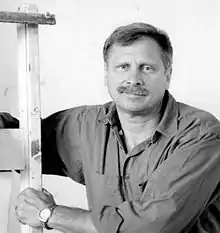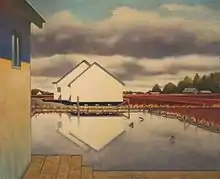Paul Havas
Paul Havas (May 23, 1940 − February 16, 2012) was an American painter. Havas is known for his landscape paintings.
Paul Havas | |
|---|---|
 | |
| Born | Paul Havas May 23, 1940 |
| Died | February 16, 2012 (aged 71) |
| Nationality | American |
| Spouse(s) | Margaret Miller Havas [1] |
Education and teaching
Paul Havas was born in 1940 in Orange, New Jersey.[2] He received a Bachelor of Fine Arts degree from Syracuse University in 1962 and went on to earn a master's degree from the University of Washington in 1965.[3] He also studied at the Corcoran College of Art and Design and was a Max Beckmann fellow at the Brooklyn Museum School of Art.[2] Havas went back to teach painting and drawing at the University of Washington, Idaho State University, and at Stanford University.[4]
Work

The subject of Havas' work changed throughout his life. In his early years, around 1970, while living on Capitol Hill in Seattle, Havas painted depictions of trucks.[5] Later in his career, he painted landscapes using oil on canvas.[6] Havas spent 14 years, from 1970 to 1984, living and painting on Fir Island, located in the Skagit Valley.[2][4] The subject of the work he painted there was his surroundings: the farmlands of the Skagit Valley, the Cascades to the East, and the San Juan Islands to the West.[7] His work in the Skagit Valley was influenced by his early training in abstract expressionism,[4] and although he did not identify himself as an impressionist, he concentrated on light and how it fell across the subject of his work.[8] Wesley Wehr described Havas's Skagit Valley landscapes as "filled with the diffuse light of spring and summer in the valley".[9] Some of Havas' paintings from this time were a part of the Northwest/New York Group Show at the Bayard Gallery in New York in 1980 and can be found in the Museum of Northwest Art in La Conner, Washington.[2]
Upon moving back to Seattle in 1984, Havas began painting night cityscapes and urban northwest landscapes.[2] However, by 1993, around the time that he helped found the Northwest Figurative Artists' Alliance, he had resumed the creation of wilderness scenes, including both wide views and close-up depictions of specific elements of nature.[8][10] Between these cityscapes and wilderness scenes, Havas began shifting the perspective of his paintings indoors. The viewer of the painting sees both a piece of the inside of the house and the view of the landscape or cityscape through a window.[2] In a similar fashion, Havas also placed paintings within paintings, as seen in his work Piano and Painting, which features a painting of Lummi Island on the wall inside of a house. Lummi Island was a setting that Havas employed as he continued his work into the 2000s. His 2001 exhibition at the Woodside/Braseth Gallery, where his art was frequently displayed, included several paintings of Lummi Island.[7] He continued his work near his summer home by the mouth of Willapa Bay, painting landscapes in and around Oysterville, WA in the CDP of Tokeland, WA.[4][6]
Death
Havas died at the age of 71 of pancreatic cancer on February 16, 2012.[4]
External links
References
- Elston, William E. (February 19, 2012). "A Tribute to Paul Havas, 1941–2012". Northwest Figurative Artists' Alliance. Retrieved 2013-05-28.
- "Paul Havas". Gallery Mar. January 16, 2009. Archived from the original on 2009-02-07. Retrieved 2013-05-28.
- "Paul Havas". Woodside/Braseth Gallery. Retrieved 2013-05-28.
- Clemans, Gayle (March 11, 2012). "A tribute to Paul Havas, skilled NW landscape painter". Seattle, WA. The Seattle Times. Retrieved 2013-05-28.
- Farr, Sheila (May 7, 2013). "Of Trucks and Tranquility: The Paintings of Paul Havas". Seattle, WA. Seattle Metropolitan. Retrieved 2013-05-28.
- Hackett, Regina (January 5, 2006). "The Northwest, moment by moment". Seattle, WA. The Seattle Post-Intelligencer. Retrieved 2013-05-28.
- Faigin, Gary (September 2001). "Review of Paul Havas at Woodside-Braseth Gallery" (Interview). Seattle, WA: KUOW-FM. Archived from the original on 2014-04-21. Retrieved 2013-05-28.
- Ament, Deloris (January 20, 1993). "A Focus On Northwest Landscape". Seattle, WA. The Seattle Times Company. Retrieved 2013-05-28.
- Wehr (December 2014). ACCIDENTAL COLLECTOR (cl). University of Washington Press. p. 177. ISBN 978-0-295-80256-5.
- Elston, William E. "A Truncated History of the Northwest Figurative Artists' Alliance". Northwest Figurative Artists' Alliance. Retrieved 2013-05-28.